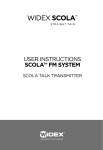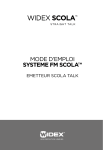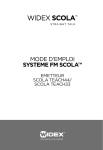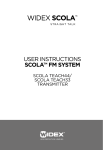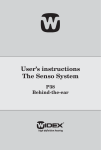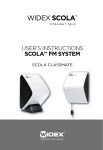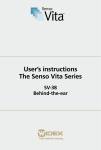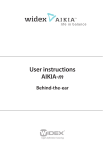Download Widex Senso Vita SV-38 Instruction manual
Transcript
User’s instructions The Senso Vita Series SV-9 Behind-the-ear Contents Your new Senso Vita SV-9 . . . . . . . . . . . . . . . . . . . . . . . . . . . . . 3 A world of new sounds . . . . . . . . . . . . . . . . . . . . . . . . . . . . 4 Having something in your ear . . . . . . . . . . . . . . . . . . . . . . . 5 Practice makes perfect . . . . . . . . . . . . . . . . . . . . . . . . . . . . . 6 The road to better hearing and a more active everyday life . . . . . . . . . . . . . . . . . . . . . . . . . . 7 Help to help yourself . . . . . . . . . . . . . . . . . . . . . . . . . . . . . . 8 The battery . . . . . . . . . . . . . . . . . . . . . . . . . . . . . . . . . . . . . . . 11 Battery type . . . . . . . . . . . . . . . . . . . . . . . . . . . . . . . . . . . . 11 Inserting the battery . . . . . . . . . . . . . . . . . . . . . . . . . . . . . 11 Changing the battery . . . . . . . . . . . . . . . . . . . . . . . . . . . . . 13 Turning the hearing aid on and off. . . . . . . . . . . . . . . . . . . . . . 14 Left/right identification . . . . . . . . . . . . . . . . . . . . . . . . . . . . . . 15 Placing Senso Vita SV-9 on/in the ear . . . . . . . . . . . . . . . . . . . 16 Removing Senso Vita SV-9 . . . . . . . . . . . . . . . . . . . . . . . . . . . 17 Automatic adjustment of loudness . . . . . . . . . . . . . . . . . . . . . 18 Fine tuning loudness . . . . . . . . . . . . . . . . . . . . . . . . . . . . . . . . 19 Listening programs . . . . . . . . . . . . . . . . . . . . . . . . . . . . . . . . . 20 Listening programs: . . . . . . . . . . . . . . . . . . . . . . . . . . . . . . 21 Switching between the listening programs . . . . . . . . . . . . . 22 Keeping Senso Vita SV-9 clean . . . . . . . . . . . . . . . . . . . . . . . . 24 Cleaning accessories . . . . . . . . . . . . . . . . . . . . . . . . . . . . . 24 The hearing aid . . . . . . . . . . . . . . . . . . . . . . . . . . . . . . . . . 25 The earmold . . . . . . . . . . . . . . . . . . . . . . . . . . . . . . . . . . . 25 Caring for your hearing aid . . . . . . . . . . . . . . . . . . . . . . . . . . . 27 Good advice . . . . . . . . . . . . . . . . . . . . . . . . . . . . . . . . . . . . . . 29 Accessories . . . . . . . . . . . . . . . . . . . . . . . . . . . . . . . . . . . . . . . 31 In case of malfunction . . . . . . . . . . . . . . . . . . . . . . . . . . . . . . . 34 2 Your new Senso Vita SV-9 We hope you will be pleased with your new Widex hearing aid. We have included these user’s instructions to inform you about the various aspects associated with wearing hearing aids. The instructions are made up of two parts: The first part is an introduction to life as a hearing aid user, how to get used to new sounds, etc. The second part contains facts about your hearing aid. How to operate and maintain it and what you can do if you experience problems. Both parts are equally important, so we recommend that you read the entire booklet to get full satisfaction of the quality and performance we have built into your new Senso Vita SV-9 hearing aid. 3 A world of new sounds Becoming a hearing aid user can be an exciting challenge. Your hearing aid does not restore normal hearing, but it brings back sounds that you may not have heard or thought about for years - everyday sounds such as a ticking clock, dripping water, the television, the car, footsteps on hard floors, children’s voices, music, doors banging, laughter, tools, machinery, etc. All these sounds can be a bit overwhelming. Try to identify and localize the sounds you are not accustomed to hearing. Once you get used to hearing these everyday sounds again, they will become a part of your active world of sounds. 4 Having something in your ear Your ears need to become accustomed to your new hearing aids. If you are a first-time user, you also have to get used to having something in your ear. It is not uncommon to feel a sensation of pressure in the ear for the first few days and your ear canal may feel warm and a bit sore. But if wearing the hearing aid causes you outright discomfort, you should consult the hearing healthcare professional where you received your hearing aid. 5 Practice makes perfect It is a good idea to start slowly and wear your hearing aids for just short intermittent periods of time, for example one or two hours, and first try them in situations with few people and not too much noise. Gradually you can use them for longer periods of time and in noisier environments. It is important that you allow yourself the time needed to get used to the new sounds and the new sensation in your ears. 6 The road to better hearing and a more active everyday life Your hearing aids may help you regain the pleasure of communicating with other people and increase your quality of life. So, although it may feel like a big challenge in the beginning, it will be worth the effort. 7 Help to help yourself Most modern hearing aids are designed with a multitude of options, settings and features to benefit most hearing aid users. Your Senso Vita SV-9 hearing aid is set individually to your hearing loss and hearing to ensure the best and most comfortable sound reproduction. After a period of use, your hearing aid may have to be fine tuned by your hearing healthcare professional. Maybe you have discovered new needs or maybe there are situations where the loudness level or sound reproduction is not satisfactory. The more details you can provide for your hearing healthcare professional about your initial experience with the hearing aids, the easier it is to find the right solution. Before your next consultation with your hearing healthcare professional, it is important that you notice how your new hearing aids feel. 8 Make a note of the situations where you are not satisfied and why. Is the problem related to low frequency, high frequency, weak or loud sounds? Is it all the time or only in specific situations? Try to describe your experiences as detailed as possible so that you and your hearing healthcare professional have something to go on when you meet again. 9 Senso Vita SV-9 1. Microphone openings, where the sound enters the hearing aid. 2. Volume control is available in some Senso Vita SV-9 models. It makes it possible to fine tune the automatically adjusted loudness. 3. Program button, which allows you to choose among different listening programs. 4. On/off switch 5. Battery drawer with a nail grip for easy opening. 6. Earhook. 7. Plastic tubing. 8. Earmold. �� 9. Sound outlet. �� 10.Relief vent. �� �� �� �� �� �� �� �� 10 ��� The battery Battery type The recommended battery type for your Senso Vita SV-9 is: Zinc Air battery type 13 For acquisition of batteries, consult your hearing healthcare professional. Please note the expiration date on the battery pack. To ensure proper battery function, do not use batteries past the expiration date. Because they are Zinc Air type batteries, they need air to work. Therefore, do not remove the adhesive tab until just before inserting the battery in the hearing aid. Once the tab has been removed, the battery will start functioning after a few seconds. The lifetime of the battery depends on a number of factors, such as the setting of your hearing aid, how many hours you use it daily and the listening environments in which you use it. Inserting the battery Before inserting a new battery in your hearing aid, remember to remove the adhesive tab. Do not use batteries on which there is a sticky residue from the tab or other unwanted substance as this can block the battery airholes. 11 Push the nail grip upwards to swing open the battery drawer. The nail grip is located on the opposite side of the on/off switch at the bottom of the hearing aid. The plus (+) sign of the battery must face upwards. If the battery drawer does not close easily, the battery is incorrectly inserted. 12 Changing the battery If you hear four rapid beep-tones while wearing your hearing aid, it is an indication that the battery is nearly exhausted. Once the battery is totally exhausted, the hearing aid will be completely silent. Exactly how long the hearing aid will function after the beeptones varies from one case to another. We recommend that you always have a spare battery with you. Never leave an exhausted battery in the hearing aid. Exhausted batteries may leak, which could damage the hearing aid. When changing batteries, it is a good idea to hold the hearing aid over a table or a carpet, in case you drop the hearing aid or battery. 13 Turning the hearing aid on and off The battery drawer is placed at the bottom of the hearing aid. The battery drawer also functions as the on/off switch. The hearing aid is turned on when the switch is pushed upwards, and off when the switch is pushed downwards. The word “OFF” is clearly visible on the switch when the aid is turned off. Please remember to switch the hearing aid off when it is not in use. Remove the battery if the hearing aid will not be used again soon. 14 Left/right identification If you wear hearing aids on both ears, your hearing healthcare professional can install a color marker to help you easily identify the hearing aid for your right versus left ear. 15 Placing Senso Vita SV-9 on/in the ear Insert a battery in your hearing aid. We recommend that you turn off the hearing aid before placing it on the ear. First insert the earmold in the ear canal while holding the lower part of the tubing. It may also be helpful to pull the outer ear backwards and upwards with the opposite hand. Once the earmold has been inserted, you place the hearing aid behind the ear, so that the hook rests comfortably on the ear, close to your head. When the hearing aid is in its correct position, turn on the hearing aid. 16 Removing Senso Vita SV-9 First remove the hearing aid from its position behind the ear. Carefully pull the earmold out of the ear canal, while holding the lower part of the tubing. If it is difficult, it may help to try to move the earmold carefully from side to side while pulling it out. It may also help to pull the outer ear backwards and upwards with the opposite hand. 17 Automatic adjustment of loudness Senso Vita SV-9 adjusts loudness automatically in accordance with your sound environment. Several thousand times per second, Senso Vita SV-9 analyzes the surroundings and tailors its sound accordingly. With Senso Vita SV-9 you do not have to think about adjusting the volume – it happens quite automatically. Important: If the volume in your hearing aid is too loud or too weak, or if the reproduced sounds are distorted, or you would like any further information, consult the hearing healthcare professional where you received your hearing aid. 18 Fine tuning loudness Your hearing aid may be provided with a volume control, shaped like a small lever. Push the lever upwards to raise the automatically set volume. Push the lever downwards to lower the volume. Use short touches for minor corrections of the volume. Faster adjustments are obtained by keeping the lever pressed for some seconds. When you raise the volume, you will hear a beep-tone for each step the volume is raised. When you lower the volume, you will hear a higher beep-tone for each step the volume is lowered. When the maximum or minimum adjustment level is reached, a steady tone will sound until you release the lever. Any adjustment of the automatic volume setting will be cancelled when your hearing aid is turned off. 19 Listening programs Your Senso Vita SV-9 may be equipped with a number of listening programs optimized for different listening situations. Your hearing healthcare professional can help you select the programs that are of use to you and make them available on the hearing aid program button. If your needs change over time, the combination of listening programs can be changed. In these user’s instructions, the hearing healthcare professional can list the listening programs that are available in your hearing aid (see page 24). 20 Listening programs: Your Senso Vita SV-9 hearing aid may be provided with up to four listening programs optimized for different listening situations. You can select the program that is most appropriate for your sound environment. Quiet (the hearing aid microphone picks up sounds from all directions). This program is recommended for quiet environments. Noise (the hearing aid microphone focuses on sounds coming from the direction in which you turn your head by attenuating sounds coming from behind). This program is recommended for noisy environments where you wish to focus on speech. T (telecoil). This listening program will be most useful with an induction loop system. It may also be useful with hearing aid compatible telephones. By selecting this program you can listen to the sound source and shut out surrounding sounds. M+T. This listening program is a combination of the Quiet and T (telecoil) programs. If you activate “M+T” you can listen to the source of sound and still hear the surrounding sounds. 21 Switching between the listening programs Switch between the programs by using the program button on the back of the hearing aid, just above the battery drawer. Each time you switch to another program, you will hear beep-tones. The number of beeps tells you which program you are in; one beeptone for program 1, two beep-tones for program 2, three beep-tones for program 3 and four beep-tones for program 4. Please note that if, for example, you only have 3 programs, program 3 will be followed by program 1 as you switch programs. If you – in consultation with your hearing healthcare professional – decide on other combinations of programs later, these can be written on the blank form found at the back of these instructions. 22 Listening program form Program Chosen programs: 1. 2. 3. 4. 23 Application: Keeping Senso Vita SV-9 clean Cleaning accessories The following accessories are available for your hearing aid: 1. Battery magnet to facilitate insertion of the battery into the battery drawer. 2. Wax removing tool for cleaning the relief vent opening. 3. Soft cloth for drying and cleaning the hearing aid. �� �� �� Additional supplies of accessories can be acquired from the hearing healthcare professional where you received your hearing aid. 24 The hearing aid Never wash your hearing aid with water, cleaning solutions or other liquids. Instead, clean your hearing aid with a dry soft cloth after use. When the hearing aid is not in use, it is a good idea to leave the battery drawer open, so as to ventilate the hearing aid and allow it to dry. The earmold Make sure that your earmold is clean and free of earwax and moisture. If it is plugged, clear the opening with a wax removing tool. 25 Disconnect the plastic tubing from the hook of the hearing aid at least once a week and wash the earmold in lukewarm water. Rinse the earmold thoroughly and allow it to dry overnight. If there is still moisture in the earmold the next time you want to use the hearing aid, use a small blower which can be obtained/ purchased through your hearing healthcare professional. Never use alcohol or other cleaning solutions to clean your earmold. If your earmold tubing becomes slack, stiff, yellow or cracked. Consult with your hearing healthcare professional for a replacement. 26 Caring for your hearing aid With proper care, your hearing aid will give you years of reliable service. Here are some things you can do to prolong the life of your hearing aid: • Switch your hearing aid off when it is not in use. Should you not use it for a day or more, take out the battery to avoid battery leakage. • Treat your hearing aid as the valuable object it is: with care. Keep it in its case in a cool, dry location where it cannot be reached by children or pets. • Never expose it to extreme temperatures or high humidity. • Do not wear your hearing aid in the shower or swimming, or when using a hair dryer, hair spray, or other sprays. Use care when applying topical lotions such as sunscreen. • Never try to open or repair the hearing aid yourself. 27 • Do not wear your hearing aid during x-ray, MR scans, CT scans, short-wave diathermy, or similar radiation treatments and never place your hearing aid in a microwave oven. These are some of the types of radiation that can damage your hearing aid. Radiation from, for example, room surveillance equipment, burglar alarms, and cellular telephones, is weaker and will not damage your hearing aid, but may at times cause interference noise. • Widex hearing aids are not certified for use in mines or other areas with explosive gases. 28 Good advice • You may notice increased accumulation of earwax with hearing aid use. Contact your ENT doctor/ physician if you suspect that a plug of earwax has accumulated in your ear. Earwax may not only reduce your own hearing but also the effect of the hearing aid considerably. It is a good idea to ask your physician to clean your ears a couple of times a year. • Please be sure to keep your hearing aid and its accessories out of the reach of children, who might place them in their mouths. Also keep batteries out of children’s reach and discard used batteries carefully. Do not change batteries in front of children or let them see where you keep your supply. • Never put a battery in your mouth for any reason as you may risk swallowing it. In case of ingestion, contact your physician immediately. In case of ingestion, contact your physician immediately and The National Button Battery Ingestion Hotline at: (202) 625-3333. • The hearing aid is made of modern non-allergenic materials. Still, in rare cases skin irritation can occur. If you notice skin irritation in or around your ear or ear canal, contact your hearing healthcare professional. 29 • Please be aware that the use of any type of hearing aid/earmold may involve a slightly increased risk of infection in the ear canal. An infection can arise as a result of inadequate ventilation of the ear or scratches in the ear canal caused by the hearing aid/earmold. Therefore, we recommend that you take out your hearing aid/earmold at night to allow the ear canal to be ventilated. Make sure that you clean and inspect your hearing aid/ earmold as required. If an infection occurs it is a good idea to clean your hearing aid/earmold with a disinfecting tissue or the like and seek medical advice. Do not under any circumstances use alcohol, chlorine or similar substances to clean your hearing aid/earmold. 30 Accessories Audio input Your Senso Vita SV-9 hearing aid can be furnished with an audio shoe. This allows direct connection to different kinds of accessories (radio, TV, FM systems and BiCROS). When an audio shoe is connected to the hearing aid, the telecoil signal is replaced by the signal from the external audio equipment. If you set the program button to the MT position, you will hear both the sound from the external audio equipment and the sound from the hearing aid microphone. If the program button is set to T, only sound from the external audio equipment will be heard. To receive sound from the telecoil again, you need to remove the audio shoe and shift to the MT or T program. 31 Important: If the hearing aid is connected to an accessory requiring use of a power outlet, the accessory unit must conform with safety requirements stated in the international standard IEC 65. Do not connect the hearing aid to sockets that are labelled with one or more of the following symbols: For more information on the use of audio input consult the hearing healthcare professional where you received your hearing aid. 32 FM systems FM systems can be used in connection with the Senso Vita SV-9. The FM system makes it easier to understand speech in difficult listening situations. An FM system consists of a transmitter (with a microphone) and a receiver which attaches to the audio input boot of the Senso Vita SV-9. The use of the FM system gives you the ability to hear clearly at a distance up to 45 feet. Both the speaker wearing the transmitter and the listener using the receiver obtain the freedom to move around within the specified range. Please be advised that some FM systems used with the Senso Vita may have an additional switch on the receiver. Please review the instruction manual of the FM system or consult with your hearing healthcare provider for the proper operation of the FM unit switch. For more information regarding the use of FM systems with your Senso Vita SV-9, consult your hearing healthcare professional. 33 In case of malfunction The following pages include some quick advice to follow if you experience problems. Before contacting your hearing healthcare professional, please follow the advice below: If the hearing aid is dead, it could be because: • The instrument is not turned on. Make sure the battery drawer, which functions as the on/off switch, is pushed all the way upwards and that the word “OFF” is not visible on the switch. • The battery is dead or does not work. Insert a new battery. Make sure the battery is placed correctly and that the battery drawer is closed correctly. • The sound outlet of the earmold is blocked. Blockage of the sound outlet of an earmold is often caused by earwax. Clean the blocked sound outlet. 34 If the hearing aid volume is not powerful enough, it could be because: • The battery is nearly exhausted. Insert a new battery. Make sure the battery is placed correctly and that the battery drawer is closed correctly. • The sound outlet of the earmold is blocked. Blockage of the sound outlet of an earmold is often caused by earwax. Clean the blocked sound outlet. • Your ear is blocked by earwax. Contact your ENT doctor/physician. • Your hearing may have changed. Contact your hearing healthcare professional. 35 If the hearing aid whistles continuously, it could be because: • Your ear is blocked by earwax. Contact your ENT doctor/physician. • The tubing is broken. Contact your hearing healthcare provider to have the tubing replaced. • The tubing is yellow and stiff. Contact your hearing healthcare provider to have the tubing replaced. • The tubing often comes off the earmold or hearing aid hook. Contact your hearing healthcare provider to have the tubing replaced. • The hook or elbow is cracked. Contact your hearing healthcare professional. 36 • The earmold is not correctly placed in your ear canal. Take the earmold out and reinsert it. It is important that the earmold is placed correctly in your ear canal. • The earmold fit is too loose. Contact your hearing healthcare professional. If the hearing aid performs intermittently, it could be because: • The on/off switch is dirty. Push the switch back and forth a couple of times. 37 Listening program form Program Chosen programs: 1. 2. 3. 4. 38 Application: Listening program form Program Chosen programs: 1. 2. 3. 4. 39 Application: Widex, Denmark • DK-3500 Vaerloese www.widexusa.com Reorder # CIB64 Printed by FB / 06-04 9 514 0046 041 #01










































